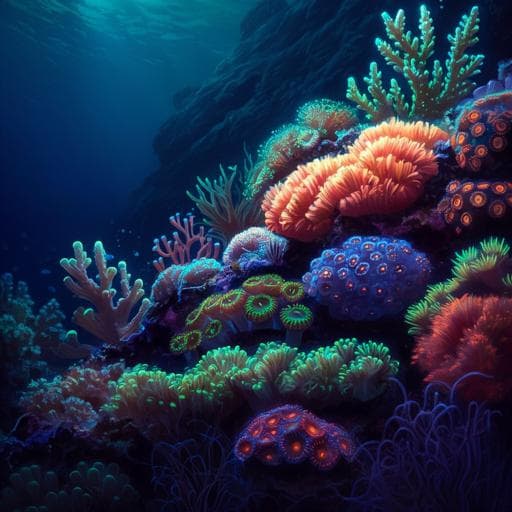
Biology
Multi-omics determination of metabolome diversity in natural coral populations in the Pacific Ocean
M. M. Reddy, C. Goossens, et al.
Explore the fascinating realm of reef-building corals with insights from groundbreaking research conducted by authors including Maggie M. Reddy and Corentine Goossens. This study uncovers the distinct metabolic profiles of two coral genera and one hydrocoral, revealing the intricate interplay of biological and environmental factors in the Pacific Ocean's vibrant ecosystems.
~3 min • Beginner • English
Introduction
The study addresses how natural coral holobionts (the coral animal, endosymbiotic dinoflagellates, and associated microbiome) vary in their metabolome across genera, genotypes, and environments, and develops a standardized, scalable multi-omics metabolomics workflow. Coral reefs face accelerated warming and acidification that destabilize symbiosis and drive bleaching, yet metabolic responses in situ remain incompletely understood. Metabolomics offers a window into organismal physiological state, but coral metabolome coverage has been constrained by disparate extraction and analytical methods and limited reference libraries. The Tara Pacific expedition enabled sampling of natural populations across environmental gradients to ask: (1) Can a unified biphasic extraction coupled to LC-MS (lipidome) and 1H NMR (polar metabolites) robustly survey the coral holobiont metabolome? (2) How do metabolomic profiles vary among coral genera, genotypes, and geographic locations with distinct temperature regimes? (3) To what extent do endosymbiotic dinoflagellates versus environment explain metabolomic variation?
Literature Review
Previous coral metabolomics employed varied extraction and analytical platforms—GC-MS, LC-MS, and 1H NMR—each with strengths and limitations. Early work used modified Folch (CHCl3/MeOH/H2O) with LC-MS/MS; others advocated single-phase 70% aqueous MeOH extractions for NMR or LC-MS. Biphasic methods (Bligh and Dyer modifications, Matyash using MTBE) have shown improved recovery of small polar metabolites and non-toxic solvent profiles. Studies have examined thermal stress, disease, bleaching history, and defense, often under laboratory conditions; fewer combined ex situ with in situ, and biogeographic metabolomic variability remains understudied. Prior coral metabolomics annotations were limited, with putative identifications and scarce standards; DMSP was frequently reported by MS, while NMR-based annotations were relatively few (e.g., homarine, taurine betaine, proline betaine, glycine betaine), and lipidomic surveys highlighted symbiont-derived lipids. This context underscores the need for standardized workflows and expanded annotation libraries to capture coral holobiont chemical diversity.
Methodology
Study design and sampling: Natural populations of three coral holobionts were sampled by SCUBA during Tara Pacific: two scleractinian genera (Pocillopora spp., Porites spp.) and one hydrocoral (Millepora cf. platyphylla). For method development, 36 fragments (12 per genus) were selected from two islands representing distinct Pacific marine provinces: Island 06 (Gambier Archipelago, Southeast Polynesia; Sept 2016) sites 01 (23°04′29.280″ S, 135°01′02.160″ W) and 02 (23°09′54.360″ S, 134°50′52.727″ W), and Island 10 (Samoa, Central Polynesia; Dec 2016) sites 02 (14°03′41.207″ S, 171°25′49.320″ W) and 03 (13°55′07.560″ S, 171°32′29.640″ W). Average SST: Gambier 25.07 °C (std 1.64) and 24.89 °C (std 1.70); Samoa 28.35 °C (std 0.92) and 28.68 °C (std 0.89). Coral fragments were flash-frozen in liquid N2 on board, stored at −20 °C, then freeze-dried, powdered, weighed, and kept at −80 °C.
Pre-analytical setup and extraction: Each sample was split into three 5 g technical replicates. A biphasic extraction modified from Matyash was used: MTBE/MeOH/H2O 7:4:1 (12 mL) sonication 5 min; add 3 mL water, sonicate 5 min; vortex; centrifuge 3500 rpm, 20 min, 10 °C to yield an upper organic phase (lipids) and lower hydroalcoholic phase (polar metabolites). Approximately 1 mL of the organic layer was reserved for LC-MS; ~6 mL of aqueous layer for 1H NMR. Solvents were removed under vacuum; extracts were weighed. Quality control (QC) samples were prepared per genus and as a cross-genus mix; blanks followed identical workflows without tissue. Extracts stored at −80 °C.
LC-MS sample prep and analysis: Organic extracts were reconstituted to 1 mg/mL with ACN/MeOH 50:50 (w/w based), filtered 0.22 μm, and analyzed on a Thermo Vanquish UHPLC with a Kinetex 1.7 μm Phenyl-Hexyl 100 Å, 100 × 2.1 mm column coupled to a Q Exactive Plus Orbitrap (HESI). Mobile phases: A = 0.1% formic acid in water; B = 0.1% formic acid in acetonitrile. Gradient: 35% B (0–2 min), to 100% B at 10 min, hold to 13 min, re-equilibrate to 35% B by 14–17 min; 0.40 mL/min; 30 °C; 5 μL injection. Acquisition in ESI+ and ESI−, m/z 120–1500, resolution 35,000. Source: sheath gas 45, aux gas 15, spray voltage 3.2 kV, capillary 320 °C, aux heater 250 °C. Runs organized with blanks, priming QCs, randomized samples, periodic QCs (every 8 injections). Four analytical batches (per genus and mixed).
LC-MS data processing and annotation: Raw files converted to mzXML (ProteoWizard). Workflow4Metabolomics (W4M) used for peak picking, grouping, RT correction, integration, blank/background removal, and QC validation; example negative mode parameters: m/z interval 0.001, S/N threshold 10, group bandwidth 5, minimum fraction 0.02. Statistics in MetaboAnalyst 5.0 and R: PCA for outlier and variability assessment; supervised PPLS-DA with permutation and double cross-validation; VIP > 1.5 considered influential; Wilcoxon tests for group comparisons. Molecular networking via GNPS in positive/negative modes: MS/MS top-6 peaks within ±50 Da windows; parent/fragment tolerances 0.02 Da; edges required reciprocal top-10 similarity; cosine ≥ 0.7 with ≥6 matched peaks. Networks curated and visualized in Cytoscape; additional processing with MZmine 2.40 (chromatogram building min height 2000, m/z tolerance 10 ppm; deconvolution S/N 10, min RT range 0.5 min; de-isotoping 10 ppm, RT tol 0.2 min; alignment 10 ppm, RT tol 1.0 min; gap filling 10 ppm, RT tol 0.3 min). Databases used: LIPID MAPS, Metabolomics Workbench, DRUGBANK, PubChem, MoNA, MASSBANK-EU, LipidBlast, MetaboBASE, MetGem.
NMR sample prep and acquisition: Hydroalcoholic extracts were resuspended in 6 mL H2O, combined with 1 mL 50 mM phosphate buffer (pH 7.4), freeze-dried, and reconstituted at 15 mg/650 μL in D2O containing 3% TMSP. Optimal NMR conditions identified: phosphate buffer 50 mM, pH 7.4, no EDTA; centrifuge 14,000 rpm, 20 min; 700 μL supernatant to 5 mm NMR tubes. Spectra acquired on a JEOL ECZR 500 MHz with z-gradient autotune probe at 25 °C using water suppression, 2 dummy scans, 32 scans, 65,536 points, 15 ppm SW, 8.72 s acquisition, 10.64 s relaxation delay. Processing included 57 mHz line broadening, phase/baseline correction, TMSP = 0.00 ppm calibration; 10.00–0.2 ppm region binned with NMRProcFlow; solvent signals removed; CSN normalization and Pareto scaling. Metabolite identification by comparison with reference compounds (commercial standards and synthetics for alanine betaine, hydroxyproline betaine, taurine betaine), spiking into representative samples per genus, and 2D NMR (COSY, TOCSY, HSQC, HMBC) for homarine; sarcosine verified via databases/Chenomx.
Genetic context: Host genotypes and Symbiodiniaceae lineages were determined from companion Tara Pacific datasets. Five Pocillopora host genotypes, two Porites genotypes, and one Millepora genotype were represented. Scleractinians mainly hosted Cladocopium at both islands; Millepora hosted Symbiodinium in Gambier and Cladocopium in Samoa, with some G and F clades. Diversity of Symbiodiniaceae was higher at cooler Gambier.
Key Findings
- Standardized, scalable metabolomics workflow: A single biphasic MTBE/MeOH/H2O extraction feeding LC-HRMS/MS (lipidome) and 1H NMR (polar metabolites) robustly captured a broad metabolome, with three technical LC-MS replicates per biological replicate confirming reproducibility.
- Expanded chemical annotation: Identified and added 24 polar metabolites by 1H NMR (18 annotated via standards, 6 unknowns), including amino acids, acetate, formate, choline derivatives, and small betaines (GlyB, AlaB, ProB, HProB, homarine, trigonelline). Putatively annotated >210 lipids via LC-MS/MS and molecular networking (cosine > 0.7), organized into 14 clusters: glycerolipids (DG, TG, MGDG, DGDG), betaine lipids (SQDG, MGCC/lyso-DGCC, DGCC, DGTS), phospholipids (PA, LPC, PC), platelet-activating factors (PAF) and lyso-PAF, and fatty acids/amides (e.g., hexadecanamide, erucamide).
- Genus-level metabolomic distinctness: PCA of LC-MS and 1H NMR showed clear separation among the three coral host genera. Lipid families were shared but differed in concentrations and fatty acyl compositions. Betaine lipids drove genus-level separation: DGCC 38:6 (16:0/22:6) central, with MGCC 16:0 and MGCC 22:6 derivatives. Diacyl DGCC predominated in Millepora and Porites, while monoacyl MGCC were more abundant in Pocillopora. PAF/lyso-PAF were present in all genera; bioactive PAF C16/C18 detected only in Pocillopora.
- Polar metabolite genus specificity: NMR profiles were highly distinct with limited shared signals. Major metabolites: Millepora (HProB, sarcosine), Pocillopora (GlyB), Porites (acetate, TauB, AlaB, homarine; trigonelline at lower levels). Homarine was abundant in Porites and absent in the other genera.
- Geography/environmental effects: Lipidomes differed significantly between islands (Gambier vs Samoa) within each genus, with some site-level variation. DGCC were enriched in Gambier (cooler, more variable SST), MGCC enriched in Samoa (warmer, more stable SST) for Millepora and Pocillopora; trend less pronounced in Porites. NMR supported island-level differences particularly for Porites. A potentially novel sulfolipid cluster was prevalent in Millepora from Gambier.
- Symbiont vs environment: Gambier hosted higher Symbiodiniaceae diversity; Samoa was dominated by Cladocopium. While symbiont identity contributed to lipidomic variation (e.g., Millepora with Symbiodinium vs Cladocopium), metabolomic differences persisted even when symbiont genus was constant (e.g., Porites with Cladocopium C15 at both islands), implicating environmental drivers and holobiont interactions.
- Genotype effects: Despite multiple host genotypes in Pocillopora and Porites, distinct chemotypes did not align with host genotypes across or within islands.
- Notable observations: DMSP was not detected by 1H NMR despite prior MS reports; suggests either absence in these samples or NMR sensitivity limitations.
Quantitative/contextual details: 36 samples (12 per genus), three technical LC-MS replicates per biological replicate, 14 lipid clusters, >210 lipids putatively annotated, 24 polar metabolites by NMR, SST means ~25 °C (Gambier) vs ~28.5 °C (Samoa).
Discussion
The unified biphasic extraction combined with LC-MS and 1H NMR provided a comprehensive, scalable survey of coral holobiont metabolites, addressing the lack of standardization in coral metabolomics. The strong genus-level separation in both lipid and polar metabolite profiles indicates conserved, lineage-specific metabolic architectures likely linked to evolutionary and functional differences within the holobiont. Polar betaines emerged as major, genus-specific metabolites, consistent with roles in osmoregulation and possibly photoprotection, underscoring their significance in coral physiology.
Geographic comparisons revealed consistent lipidomic shifts across cooler, more thermally variable Gambier versus warmer, more stable Samoa, with DGCC enriched in cooler Gambier and MGCC enriched in warmer Samoa for two genera. These shifts, alongside detection of a novel sulfolipid family in Millepora at Gambier, suggest environmental modulation of lipid metabolism, potentially reflecting differences in storage versus structural lipids and thermal acclimatization strategies. Importantly, differences persisted even when the same Symbiodiniaceae genus/lineage was present (e.g., Porites with Cladocopium C15 at both islands), indicating that symbiont identity alone does not explain metabolic divergence; rather, it reflects an interactive outcome of host, symbionts, associated microbiota, and environmental conditions. The absence of genotype-associated chemotypes further supports environment and holobiont composition as primary drivers of metabolomic plasticity in situ.
Collectively, these findings provide baseline metabolic signatures across taxa and environments, highlighting candidate metabolites and lipid classes that may underpin stress tolerance and adaptive responses, and demonstrate the utility of integrated MS/NMR workflows and molecular networking for broad metabolome coverage and annotation.
Conclusion
This study establishes a standardized, scalable biphasic extraction coupled to LC-HRMS/MS and 1H NMR for comprehensive metabolomics of coral holobionts and expands the coral chemical reference space by unambiguously identifying 24 polar metabolites via NMR and putatively annotating over 210 lipids via MS. Metabolomes were highly genus-specific and environmentally responsive across biogeographic provinces, while host genotypes did not explain chemotypic variation. Symbiodiniaceae composition contributed to variation but did not fully account for observed differences, implicating combined holobiont-environment interactions. The dataset provides foundational baselines for future monitoring and mechanistic studies of coral resilience.
Future directions include: isolation and structural confirmation of the putative novel sulfolipid family; targeted quantification of key betaines and betaine lipids across broader gradients and time series; expansion of lipid standard libraries to improve MS annotation confidence; integration with transcriptomics/proteomics/microbial metagenomics to link metabolites to pathways and taxa; and longitudinal and experimental manipulations to disentangle environmental versus symbiont-driven effects.
Limitations
- Sample scope: Method development used a subset of 36 samples from two islands and limited sites/time points, which may constrain generalizability across seasons and broader Pacific regions.
- Annotation confidence: MS-based lipid identifications are largely putative (cosine similarity, database matches) due to limited availability of pure lipid standards; full structural elucidation (e.g., for novel sulfolipids) requires isolation and NMR/MSn.
- Sensitivity and coverage: 1H NMR targets major polar metabolites and may miss low-abundance compounds (e.g., DMSP not detected), while LC-MS emphasizes medium-to-low polarity; neither technique alone captures the complete metabolome.
- Holobiont attribution: Metabolites cannot be unambiguously assigned to host, symbiont, or microbiome members without additional spatial or single-cell approaches; environmental covariates beyond temperature may also contribute.
- Genotype resolution: Although multiple host genotypes were present, sample sizes per genotype and site were modest, potentially limiting power to detect subtle genotype-specific chemotypes.
Related Publications
Explore these studies to deepen your understanding of the subject.







